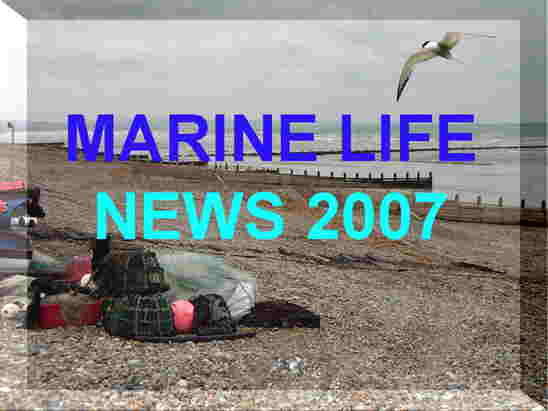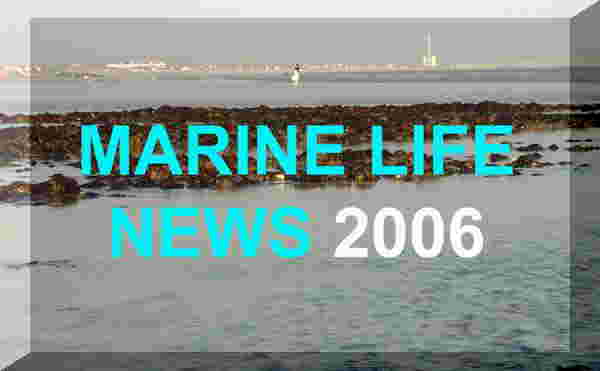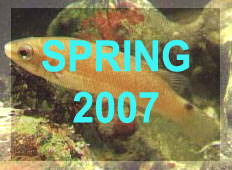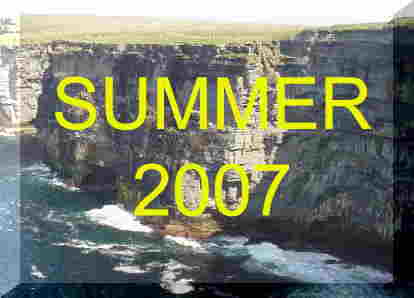EVENTS:
16-17
November 2007
Marine
Conservation Society Conferences
"Future
for Sustainable Seafood", Friday 16 November
MCS
Annual Conference "Oceans 2007", Saturday
17 November
Both
events at "Action Stations", Royal Naval Dockyard, Portsmouth
LATEST
NEWS:
29
December 2007
A
juvenile Loggerhead
Turtle, Caretta
caretta, was discovered washed up dead at Ardnave
on the island of Islay,
the southernmost island of the Inner
Hebrides, western Scotland.
Marine
Conservation Society
BMLSS
Turtles
A
Basking
Shark,
Cetorhinus maximus,
is spotted in St.
Loy's Cove, south Cornwall, unusual so late in the year.
BMLSS
Basking Sharks
15
December 2007
A
Humpback Whale, Megaptera novaeangliae, was
discovered dead off the south Wales coast near Aberavon.
The animal, which is about 4.5 metres long, was reported floating in the
Port
Talbot harbour area earlier in the day. It is probably the same whale
that was seen alive one week earlier.
Earlier
Report
 14
December 2007
14
December 2007
Ray
Fallaize caught a record Couch's
Sea-Bream,
Pagrus
pagrus, on rod and line from a boat
in Guernsey waters on 28 April 2007.
His capture has been accepted by the British Record Angling Committee.
It weighed 6 lb 9
oz
7 drams (3 kg).
Link
to the Full Report & Photograph
Sealord
Photography
British
Sea Angling Records (boat)
BMLSS
Couch's Bream
BMLSS
Sea Breams
8
December 2007
A
Humpback Whale, Megaptera novaeangliae, was
observed and photographed
off Mumbles in south Wales. It
came within 30 metres of the pier
at Nab Rock.
Gallery
Humpback
Whales, Megaptera novaeangliae, are
rare in British seas, but have been observed more frequently in recent
years. They can be identified by their large white pectoral fins. From
a distance they resemble Fin Whales,
but Humpbacks
raise their tails before diving.
Whales
& Dolphins in British Seas (by Steve Savage)
UK
Cetnet (Yahoo Group)
24
November 2007
 We
saw what we initiallly thought was a Striped Blenny, Parablennius
rouxi, off Plymouth. We dived at 50° 17.363N and 004°
00.187W out of Fort Bovisand. It was a flat sandy bottom with low (1 metre)
rocky ridges covered in mixed animal turf at between 22 metres and 24 metres
in depth. There were loads of sponge species and quite a few pink seafans
and Imperial Anemones,
Aureliania
heterocer.
We
saw what we initiallly thought was a Striped Blenny, Parablennius
rouxi, off Plymouth. We dived at 50° 17.363N and 004°
00.187W out of Fort Bovisand. It was a flat sandy bottom with low (1 metre)
rocky ridges covered in mixed animal turf at between 22 metres and 24 metres
in depth. There were loads of sponge species and quite a few pink seafans
and Imperial Anemones,
Aureliania
heterocer.
This
blenny
is a Mediterranean species and this would be the first record off the British
coast.
The
ID is not clear. It could be the
Variegated
Blenny Parablennius
pilicornis. The
head tentacles and subsequent observations make this other southern species
more likely.
UK
Diving » Plymouth » Diving from Bovisand
The
long standing (since 1987) UK shore caught
Bass,
Dicentrarchus
labrax, angling record (19
lb)
was broken by a fish that weighed
8.95 kg
(19 lb 11 oz 12 dr) caught
by local angler Steve Cave
at Sandown
Pier, Isle of Wight. The bait used was whole squid. The world shore caught
angling record is 9.40 kg (over 20 lb).
British
Sea Fish Angling Records
21
November 2007
A
five metre long Thresher Shark,
Alopias
vulpinus, was landed at Newlyn
Fish Market and was caught by skipper of the
Imogen,
Roger Nowell, whilst trawling for squid and
John Dory off Land's End, Cornwall. It weighed weighed
510 kg (1,125 lb) and was the heaviest
on record landed at Newlyn. Comparatively,
the angling record
fish weighed 146 kg. Commercial fishermen have landed Thresher
Sharks up to 400 kg before.
BMLSS
Sharks
BMLSS
Shark News
>
21 November 2007
A
massive swarm of billions of jellyfish known
as Mauve Stingers, Pelagia
noctiluca, covering several square
miles and to a depth of 11 metres, wiped out Northern Ireland's only Salmon
farm, killing more than a hundred thousand fish at Northern
Salmon Co. Ltd. The Salmon
were kept in two large nets about a mile off the coast of the Glens
of Antrim, north of Belfast. The
Salmon
hatchery is on Glenarm River deep within the Castle Estate and the smolt
were transferred by helicopter to pens in Glenarm
Bay.
The extent and size of the jellyfish
swarm was unprecedented.
BMLSS
Jellyfish
Research
References for Pelagia noctiluca
Observer
Scare article
19
November 2007
A
Bearded
Seal, Erignathus
barbatus, was seen at Chanonry
Point area on the coast of the Moray Firth near Inverness, Scotland,
having been there for about two weeks.
Link
to a Photograph
BMLSS
Bearded Seal page
BMLSS
Seals
16
November 2007
I
found a dead Triggerfish,
Balistes
capriscus, on Balnakeil
Beach by Durness (north coast of Scotland) last week, washed up following
recent gales. It came in with thousands of little jellyfish.
These jellyfish
were very small and blew away quickly on the wind.
These
were Mauve Stingers, Pelagia noctiluca.
(AH)
9
November 2007
A
tidal
surge threatened the east coast of England.
Low pressure and strong winds caused the surge. Norfolk and Suffolk had
eight severe flood warnings. High tide occurred at 7:41
am at Great
Yarmouth where the surge waters caused
minor flooding and at a few other places along the coast.
3
November 2007
The
first swarms of thousands of the Mauve
Stingers, Pelagia noctiluca, appeared
off the surfing coast at at Hornish Point, South
Uist, Outer Hebrides, Scotland.
Their
sting was a bit nippy but not as bad as the larger brown jellyfish we normally
get and they made me come out in a raised rash on my hands and face which
stung long after I was dry.

A
small Pelagia noctiluca
washed up
Photograph
by Darrell Campbell
Full
Report
BMLSS
Jellyfish
2002
Report
1
November 2007
A
large nine metres long whale was washed up dead in the Humber estuary.
It was identified as a Fin Whale,
Balaenoptera
physalis.
28
October 2007
A
Quahog
Clam, Arctica islandica,
dredged up off the coast of Iceland was thought to be between 405 and 410
years old and the oldest animal* alive
on Earth until it was killed. Researchers from Bangor
University in north Wales said they calculated its age by counting
rings on its shell.
(*This
may exclude cnidarians.)
22
October 2007
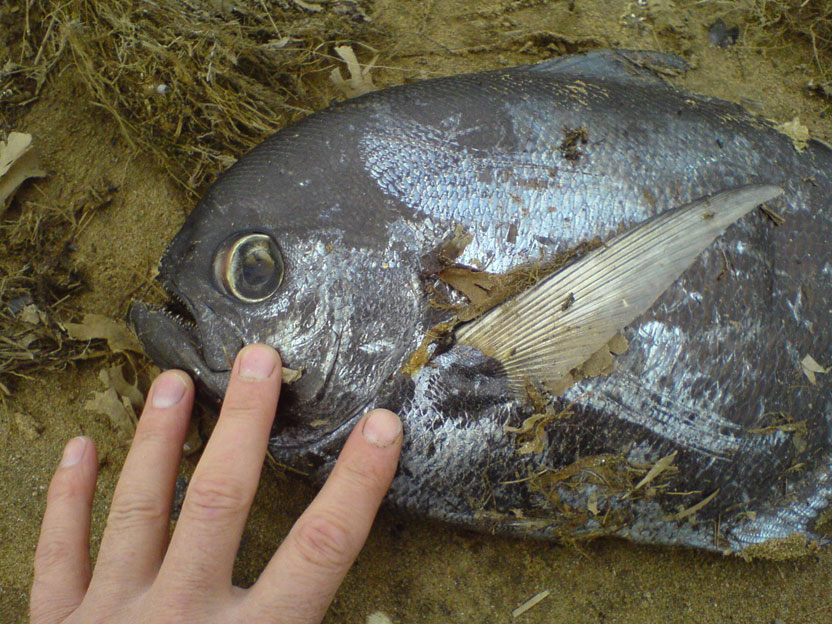
A
Ray's
Bream,
Brama
brama, was found dead on the strandline at Snettisham
RSPB, Norfolk. (Map reference TF 646 327)
BMLSS
Ray's Bream
At
least four more Ray's Bream,
Brama
brama, were discovered washed up on the Norfolk coast in early
November.
BMLSS
Norfolk Reports
21
October 2007
A
Red
Band Fish,Cepola rubescens,was
caught on rod and line in deep water from Plymouth sound breakwater.
This
fish is an unusual angling capture. The Red
Band Fish is a small fish, elongate like an
eel, that lives in vertical burrows in mud.
BMLSS
Red Band Fish
|
 |
16
October 2007
Large
Helford Sea Hares
Tony
Sutton was diving on the eelgrass bed at 5.7
metres depth in the Helford
Voluntary Marine Conservation Area, Cornwall, when he came across some
exceptionally large greenish brown sea-hares (35 cm) which attracted his
attention. When he returned a few days later with his camera he was able
to take some excellent pictures which indicated the species Aplysia
depilans. Confirmation of this
identification was established by Dr
Paul Gainey when one of the animals was
taken briefly from the water.
Full
Report and Photographs on the Helford VMCA News web pages
14
October 2007
Aplysia
fasciata at the National
Marine Aquarium
A
specimen of 30 to 35 cm and weighing 1.5 kg was caught in Poole Bay, Dorset,
just outside of Poole Harbour in a trammel net by John
Green of the FV.
Serendipity. It was caught in 3 - 4 metres
of water on sand on a flooding tide, while fishing for sole and bass.
Subsequently a further four large
sea hares
have been caught by fishermen in the same area.

Sea
Hare, Aplysia fasciata
Photograph
by Doug Herdson
It
was brought into the National Marine Aquarium
at Plymouth where it is now on show as our
"Feature Creature"
in our recently refurbished Shallow Waters, Hidden Depths exhibit, where
it is devouring very large quantities of sea lettuce Enteromorpha
latuca.
Previously,
only six specimens of this southern species of sea
hare have been recorded in British seas.

Aplysia,
the size if which (between 30 & 35 cm) indicates that it is Aplysia
. fasciata. It was photographed swimming
in Helford River,
Cornwall. It was seen by Steve Potter on
25
August 2007.
Aplysia
fasciata is the largest and the rarest of the three species of
sea hare found in the British Isles. It is an Atlantic species, found from
the Channel to Angola (South west Africa and to Brazil) and also throughout
the Mediterranean. It appears to reach its northern limit in Ireland and
along the English Channel coast.
It
is one of the largest sea slugs in the world. The other two British species
are the relatively common Aplysia
punctata variable in colour and growing to 20 cm; and the rare
Aplysia
depilans with different shaped back
lobes, brown or green and growing to a maximum of 30 cm.
BMLSS
Molluscs
BMLSS
Aplysia
Sea
Slug Forum Species List
7
October 2007

Guinean Amberjack, Seriola
carpenteri
Photograph
© by Richard
Lord (Guernsey)
All
Rights Reserved © RLLord
Sealord
Photography
Guernsey
commercial fisherman Rick Ferbrache
netted a 826 gram Guinean Amberjack, Seriola carpenteri
(originally though to be an Almaco Jack, Seriola rivoliana),
off the north-west coast of Guernsey. Rick
told me the fish was netted about 1.5 miles off Rousse at the Hoffet off
Guernsey’s north-west coast in about 20 metres of water.
BMLSS
Seriola Jacks
6 October
2007

6 October
2007
This
attractive red Long-spined Bullhead,
Taurulus
bubalis, latched on to the bait on
my friend's fishing line (without swallowing the hook) and was returned
alive to the sea off Northern Ireland. This is a common fish, but
not so often coloured bright red.
4
October 2007
Ray's
Bream,
Brama
brama, appear to have been relatively common off the west coast
of Ireland this year. They are frequently taken by Spanish registered long-liners
while targeting Hake.
Almost five tonnes were taken off the north-west coast and landed into
Killybegs
by a single vessel. Another two tonnes were landed on 18
October 2007.
BMLSS
Ray's Bream
> 4
October 2007
Two Basking Sharks,
Cetorhinus
maximus, around six metres long, were seen and
they stayed around the Farnes
Isles, NE England, for a week. Anthony
Hurd, National Trust Warden, was quoted -
"It's
only the 17th occasion these large fish have been recorded in the North
East and the first time around the Farnes."
BMLSS
Basking Sharks
Magic
Map now has a Coastal and Marine Resource Atlas
Cornish
Marine Wildlife 2006 (Ray Dennis Records)
Cornish
Marine Life 2007 (Ray Dennis Records)


